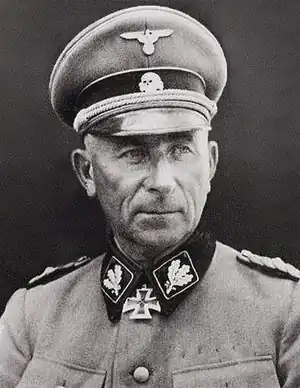Operation Cloudburst
| Operation Cloudburst | |||||||||
|---|---|---|---|---|---|---|---|---|---|
| Part of the Italian Campaign of World War II | |||||||||
 Paul Hausser, commander of the II SS-Panzerkorps in northern Italy | |||||||||
| |||||||||
| Belligerents | |||||||||
|
|
| ||||||||
| Commanders and leaders | |||||||||
|
| Unknown | ||||||||
| Strength | |||||||||
| 5,000 | Unknown | ||||||||
| Casualties and losses | |||||||||
| Unknown |
2,000 casualties 2,500 civilians (500 deported) | ||||||||
Operation Cloudburst (in Italian: Operazione Nubifragio; in German: Unternehemen Wolkenbruch)[1] was a military offensive during World War II in Italy, launched by the Germans to take control of the Julian March, and in particular of the Karst Plateau and Istria, as well as the Province of Ljubljana, which had been occupied by the Yugoslav partisans, after the Armistice of Cassibile. The civilian death toll was 2,500 killed and 500 deported,[2][3] and 2,000 casualties on the Yugoslav partisan side.[2][4]
The offensive began on the night of October 2, 1943, under the command of SS General Paul Hausser.[5] Two efficient and combative SS divisions were employed, numbering around 5,000 men:[2] the 1st SS Division "Leibstandarte SS Adolf Hitler" and the 7th SS Division "Prinz Eugen" (fresh from Dalmatia). Units of the 162nd Infantry Division "Turkmenistan",[6] the 24th Panzer Division and the 44th Infantry Division, the 71st Infantry Division "Kleeblatt", as well as small fascist republican units (recently reconstituted) were also employed.[7] On October 6, an operation in the Natisone Valley, in the Province of Udine, and resulted in 69 dead and 51 wounded partisans. For the division, the operation was intended to serve as a «training of the troops».[8] The operation ended on October 15, with the conquest of the Istrian peninsula.[2]
It resulted in the German occupation of the provinces of Udine, Gorizia, Trieste, Pula (Pola), Rijeka (Fiume) and Ljubljana (Lubiana),[9] and the creation of the Operational Zone of the Adriatic Littoral, which included parts of present-day Italian, Slovenian, and Croatian territories.[10] It was placed under the direct control of Friedrich Rainer, Gauleiter of Carinthia, who administered them as if they were in fact annexed to the Third Reich, in anticipation of a future "Greater Austria" to be established after the war.[11]
References
- ^ "Polizei-Regiment 19" (in German). Archived from the original on January 19, 2022. Retrieved March 1, 2025.
- ^ a b c d "Adriatisches Kunstenland (Zona di Operazioni Litorale Adriatico)" (in Italian). Archived from the original on April 21, 2024.
- ^ Luciani, Luciano (2004). dalla Costa, Nicolò (ed.). Gli avvenimenti alla frontiera nord-orientale : l'Alpenvorland e l'Adriatisches Küstenland (1943–45) (in Italian). p. 607. Archived from the original on May 16, 2022.
- ^ "Zona di Operazioni Litorale Adriatico" (PDF). confinepiulungo.it (in Italian).
- ^ "Istria 2 ottobre 1943, scatta l'operazione Nubifragio". Italiani in Guerra (in Italian). 2 October 2024. Archived from the original on October 7, 2024.
- ^ Thomas, Nigel; Andrew, Stephen (2000). The German Army 1939–45 (5): Western Front 1943-45. Osprey Publishing. pp. 12–13. ISBN 978-1-85532-797-9.
- ^ "Istria 2 ottobre 1943, operazione Wolkenbruch". Italiani in Guerra (in Italian). 2 October 2018. Archived from the original on February 1, 2023.
- ^ "Infanterie-Regiment 303, 162. ID (turk.), gefallen in Italien" (in German). November 6, 2021. Archived from the original on March 1, 2025. Retrieved March 1, 2025.
- ^ Tomasevich, Jozo (2001). War and Revolution in Yugoslavia, 1941-1945: Occupation and Collaboration. Stanford University Press. pp. 121–123. ISBN 978-0-8047-3615-2.
- ^ (in Italian) Online Map.
- ^ Carnier, Pier Arrigo (1982). "Lo sterminio mancato. La dominazione nazista nel Veneto orientale, 1943–1945". Testimonianze Fra Cronaca e Storia (in Italian). 115. Mursia: 16–87.
Further reading
- Neufeldt, Hans Joachim (2000) [1957]. Tessin, Georg; Kannapin, Norbert (eds.). "Zur Geschichte der Ordnungspolizei 1936–1945". Schriften des Bundesarchivs (in German). 3. Osnabrück: Biblio-Verlag. ISSN 0435-706X.